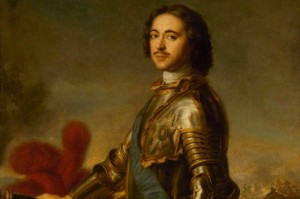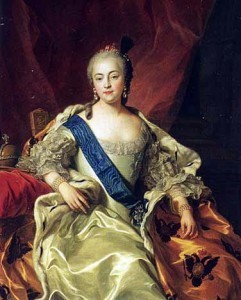The concept of a “reforming tsar” as a secular and progressive position is interesting, given the long history Russian rulership has with the Orthodox Church. Indeed, in the sixteenth and seventeenth century the tsar was a far cry from the parallel monarchs of Western Europe. He was assumed to be a protector of the lower “castes,” and, bound in such a role, was unable to provide the domineering influence necessary of a true autocratic ruler to provide guidance.
Peter the Great did away with the notion of the tsar as a servant of God, replacing it with the concept of subservience to the state as a whole. Such an ideological shift provided the motivational impetus necessary to seize the power and “modernize” Russia, as it were. Peter set into place a concept that would become the crux of tsarship until the destruction of the position in 1917. With Peter’s fascination with Western Europe, and the modernizing reforms that followed, came the idea among the Russian people that it was appropriate, if not necessary, for the tsar to take it onto himself to be a vessel for change.
Cynthia Whittaker posits that is was the concept of the “reforming tsar” that allowed the autocracy to survive so long, and abandoning the idea was what brought the position to an end. To be accepted as a worthy ruler of the people, the tsar had to be responsible for bringing innovation. In fact, many subsequent tsars claimed a connection between their own reforms and Peter’s, to feed off of the legitimacy of his innovation.
At the dawn of the 19th century, however, reform was no longer tied to Peter, but viewed as an intrinsic duty of the office of tsar. The concept of a single authority as the only political entity capable of fomenting change is reminiscent of the early Roman emperors, dictators to free the state from the floundering of a bloated and fractured ruling body. The title “Most Pious Tsar” was shed in favor of “Father of the Fatherland,” a decisive move to represent the primacy of a tsar’s mortal responsibilities over his religious ones.
An interesting thought is the parallel between the concept of the tsar’s duties as “Father” and the duties of a father in a traditional Russian household demonstrated to us in earlier sources. Both represent harsh realities of leadership and made use of a strong hand to instill discipline as the father saw fit.
 Peter the Great, First Father of the Fatherland (1672-1725)
Peter the Great, First Father of the Fatherland (1672-1725)
Whittaker, Cynthia. “The Reforming Tsar: The Redefinition of Autocratic Duty in Eighteenth-Century Russia.” Slavic Review no. 51 (1992): 77


